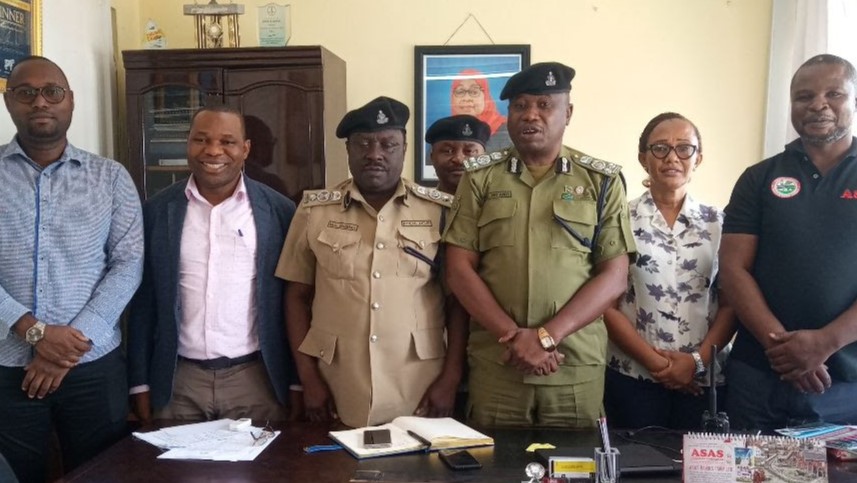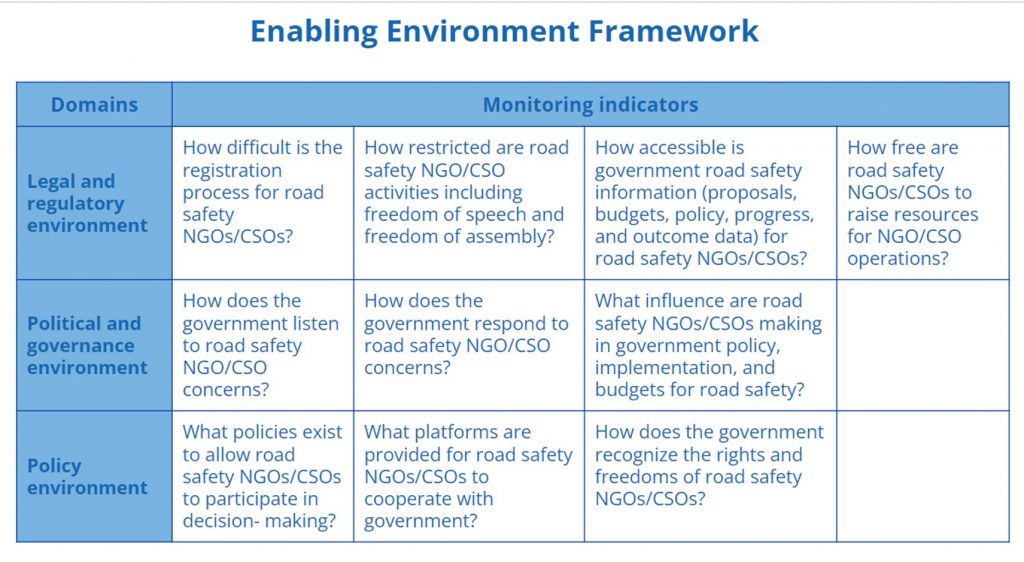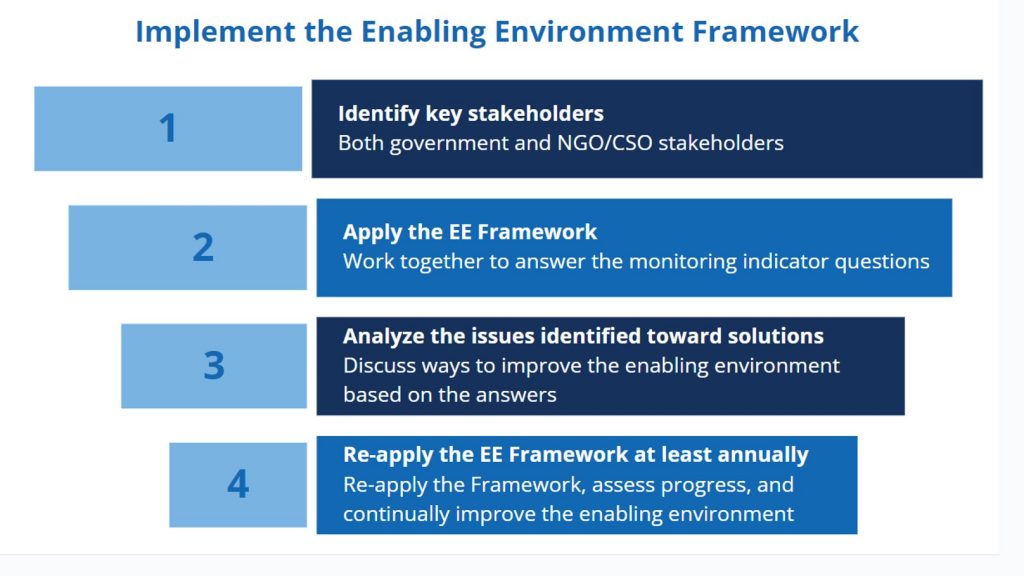
The Assessment of the Enabling Environment for Road Safety Civil Society Organizations in Three Sub-Saharan African Countries provides a framework designed to initiate discussions between government and civil society working in road safety to identify and analyze barriers and enablers for both parties to address in collaboration. The framework was published by the Alliance in partnership with local universities in Ethiopia, Uganda, and Zambia (Addis Ababa University School of Public Health, Makerere University School of Public Health, and Harvest University) and the Milken Institute School of Public Health at George Washington University.
To share what was learned from the research and its practical applications, the Alliance recently convened an online session on Enabling Environment and Framework: Strengthening Advocacy and Accountability. The panelists for the session, included road safety and human rights organizations and a parliamentary group, including M Naeem Murtaza, Technical Advisor and Focal Person, International Parliamentarian Congress; Rod King, Founder and Campaign Director, 20’s Plenty for Us; Phillipa Tucker, Eastern and Central Europe Coordinator – European Disability Forum; and Jackie Okao, Uganda in-country coordinator for the Road Safety program, Global Health Advocacy Incubator Uganda/Coordinator of Road Safety Coalition Uganda. The session explored the findings from the research and discussed how NGOs can use the framework for meaningful NGO participation and engagement with their governments.
Overview of the report’s findings
Presenting the framework, Chika Sakashita, Director of Research and Accountability at the Alliance, described that it is designed to initiate discussion between government and NGOs working in road safety. This will help to identify and analyze barriers and enablers for both parties to address in collaboration. It shows that creating an enabling environment must be a two-way regular conversation. This requires candid reflections of possible barriers and enablers in building a meaningful relationship between both parties to continually improve the enabling environment.
The framework is divided into domains – legal and regulatory environment, political and governance environment, and policy environment. Each domain has monitoring indicators, as shown in the figure below, which are guiding questions to help NGOs demonstrate effective functioning and healthy working relationships and engagement with government.

The report also proposes how to apply the framework based on four simple steps – identify key stakeholders; apply the Enabling Environment framework; analyze the issues identified toward solutions; and re-apply the framework at least annually.

Speaker highlights
The speakers highlighted some of the issues NGOs face in engaging with the government and also provided some suggestions on navigating these issues.
M Naeem Murtaza, Pakistan-Bridging the trust gap: strengthening NGO-government partnerships.
“There is a lack of trust and governments are reluctant to talk with NGOs as they feel they are not transparent. This is the reason why NGOs have not been recognized by the government to work with them”, says M Naeem Murtaza. “It is not about the NGOs not working but the relationship with the government and NGO and the effectiveness of this relationship. I believe that the NGOs can play a significant role in building trust and engaging with the government.” He was also of the opinion that despite these hurdles, NGOs possess the potential to foster trust and enhance their engagement with governments, and the effectiveness of NGO-government relationships is crucial for impactful collaboration.
Rod King, UK-Strategic advocacy: aligning with government aspirations.
Rod King said that success in advocacy hinges on aligning NGO goals with government aspirations and leveraging collaborative efforts to influence policy at different governance levels. He mentioned that effective advocacy involves understanding government policy and aligning NGO objectives with government aspirations. He mentioned that another strategy is to influence those who can in turn, influence the government. This could be people in public health, academia, etc. With this, NGOs can create allies that can help in making their advocacy more amplified, influential, and powerful to the ears of the government. “Understanding these dynamics is great for advocacy and you have to understand what levers to pull so that others will understand that what you are doing is a good idea and for them to lend their voice to your advocacy to create a stronger voice.” In addition, Rod King encouraged NGOs to ‘work with the willing’ by focusing efforts where they are most receptive, often at local or regional levels. “Work where the change is acceptable. Work locally, get the job done in many local areas and soon you will build momentum to get to the national level.”
Phillipa Tucker, Belgium-Enhancing government responsiveness through watchful advocacy, being creative and building coalitions
“Leaders make more responsible decisions when they know they are being watched, so NGOs need to watch them and let them know that they are monitoring what they do, as this seems to change government behavior. Another thing is to make their jobs easier by doing their jobs for them. For instance, if you want them to draft a letter, do the drafting and send it to them to edit. If you want a framework, develop it, and give them something to kick against. It helps them implement things faster. Commend their efforts and praise them in public but correct them and educate them in private”, says Phillipa Tucker. She noted that this public commendation and private correction, coupled with educating them is effective in gaining government support to influence their decisions.
Phillipa also stressed on the need for adaptive and creative advocacy approaches, and strategic coalition building. This is crucial for expanding the influence and effectiveness of NGOs in policy discussions, making it more challenging for governments to ignore. “There might be closed spaces in general, but there might be open spaces in other avenues, like ministries, that can help you gain entrance. Get creative in circumventing regulations that are meant to clamp you down. Do background checks on the people you are doing advocacy with to know how to narrow your advocacy speech to connect with them. Check if they have personal stories with road safety. Work in coalitions with strategic stakeholders because the more you spread out, the harder it is to close down the space and it shows that the issue is bought into by many more people”, says Phillipa Tucker.
Jackie Okao, Uganda-Unifying NGO voices for greater impact
Jackie Okao reiterated the essence of unity among NGOs which strengthens their advocacy impact, builds government trust, and enhances their role in shaping road safety policies. This is because a unified NGO voice is essential for building government trust and positioning NGOs as valuable contributors to policy discussions, particularly in road safety. “Governments like it when NGOs are contradicting each other as it reduces NGO advocacy because governments do not want to do anything. NGOs need to have a unified voice. This also helps to build government trust in NGOs and see them as people to make their work easier. This will make them come back to NGOs when road safety issues come to the top of their agenda”, says Jackie Okao.
She also highlighted that understanding how government budgeting and financial allocation works enables NGOs to engage more meaningfully in policy discussions to improve funding for road safety initiatives. “NGOs need to focus on budget advocacy and lobby for funds for road safety by accessing budget documents to know where to put their resources and time, which will support meaningful discussions on how to improve funding for road safety.”